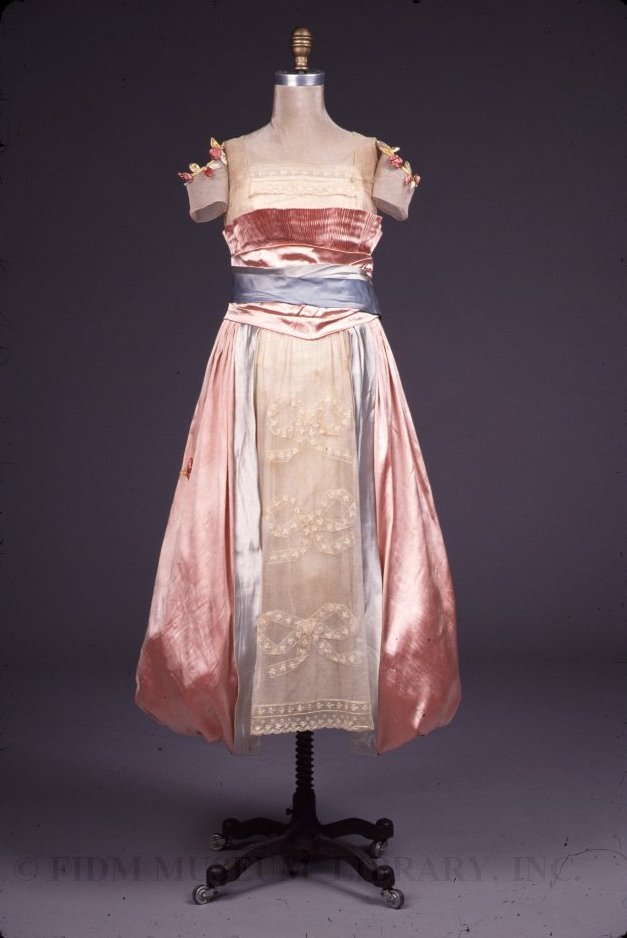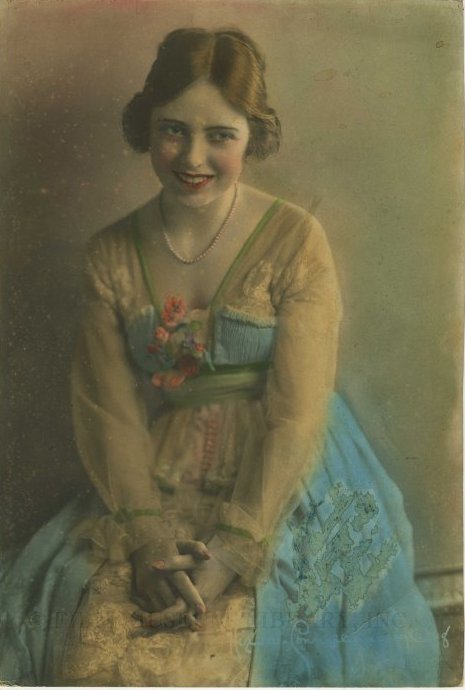As a child, Lucile Sutherland (1863-1935) designed and sewed clothing for both herself and her sister Elinor. Years later, Lucile's hobby would become the foundation of an internationally successful business. After the dissolution of her first marriage in 1888, Lucile was left with no means of supporting herself and her young daughter. Lacking any other professionally viable skills, Lucile turned to dressmaking. At first, Lucile worked as a society dressmaker in London under her married name, Mrs. James Wallace. Her business expanded rapidly and by 1894, she operated under the name Maison Lucile, eventually incorporating as Lucile Ltd. in 1903. By this time, Lucile's reputation was international. In 1907, the American edition of Pearson's Magazine encouraged all American travelers to visit Lucile Ltd. when in London, as the proprietress was "pleased to open wide her doors to all Americans–even if they have no intention of purchasing."1 Within a few years, Lucile would open international branches of her store to fulfil the demand for her designs. Lucile Ltd. New York opened in 1910, followed by a Paris store in 1911 and a Chicago store in 1915.
 Lucile
Lucile
c. 1917
Gift of Anonymous Donor
91.40.5
Lucile's first designs as Mrs. James Wallace were "personality dresses," dresses designed to best reflect the personality of the wearer. In her 1932 autobiography Discretions & Indiscretions, Lucile claimed that she "never designed a dress for any woman in those [early] days until I had succeeded…in placing her type, for dresses, if they are to give any pleasure to their wearer, must become a part of her personality."2 Lucile's personality dresses were loose-fitting teagowns, a style of informal dress that was worn primarily among close friends and/or family.
Though Lucile was concerned with making her clients look their best, she was also deeply entranced by the materials of her profession. Lucile felt "a positive intoxication in taking yards of shimmering silks, laces as airy as gossamer and lengths of ribbons, delicate and rainbow-colored, and fashioning of them garments so lovely they might have been worn by some princess in a fairly-tale."3 Lucile was also sensitive to color, taking great care to carefully layer and blend fabric and trim of different colors to give a pleasing impression. In Lucile's design vocabulary, green signified renewal and hope, blue for purity, yellow for luck and rose for love and romance.4
As her business grew, Lucile couldn't know the unique personality of every client. Instead, she honored each dress with a unique, poetic name. It "offended [Lucile's] sense of the dramatic that some creation of mine, the expression of a mood, should be spoken of only as 'number nine.' "5 The names often suggested the mood of the dress, though some names seem totally unconnected to any aspect of the design. A 1905 gown of gauze and lace was called Farewell Summer, and a dramatic blue and purple evening gown from the same year was called The Moment. A dress called The Sighing Sound of Lips Unsatisfied creates a vivid mental image, while a another dress called The Captain's Whiskers suggests something other than a romantic Lucile creation.
We haven't been able to determine the name of our Lucile gown. The light pink color is classic Lucile, as are the applique fabric flowers and inset lace bows. Lucile used bow motifs throughout her career, both on her garment labels and as a decorative element in her dresses. The pouf or bubble skirt seen on this dress is unusual for the period. This skirt shape didn't become widely fashionable until the 1950s. Was Lucile responding to the request of a particular client, or simply playing with the form and shape of a basic form, the skirt?
Lucile was noted for her innovative spirit, both as a designer and in her business practices. Though Lucile is generally associated with a romantic, feminine, 18th century inspired aesthetic, she also designed a wide-variety of more functional garments, including the "Ideal Office Gown." A plain, ankle-length, full-skirted jumper dress, the Ideal Office Gown was advertised as being perfectly suited for "Business Women and Stenographers" in the October 21, 1916 edition of the New York Times. This simple garment, so unlike her fragile, embellished evening gowns may have been inspired by a functional overdress Lucile wore when at work.
Lucile was also forward thinking in her efforts to promote her reputation. Lucile's mannequin parades, presented on an elevated stage by young women hand-picked by Lucile, are often considered the forerunner of the modern fashion show. In 1916/17, she licensed her name to Sears, Roebuck & Co. for use in promoting a line of upscale evening dresses. Lucile had also signed a licensing deal in 1915, which conflicted with the Sears, Roebuck & Co. contract. The resulting lawsuit, Wood vs. Lucy, Lady Duff Gordon is still used in law school classrooms as an example of contract litigation.
Lucile's clientele were drawn from the upper-echelons of society. After her 1900 marriage to Sir Cosmo Duff-Gordon, Lucile herself received a title, Lady Duff-Gordon. Lucile's first customer, her sister Elinor, became the noted author Elinor Glyn. Glyn herself wore Lucile's designs, and also referred her friends to Lucile. Other important customers were Daisy Warwick, Margot Asquith and several granddaughters of Queen Victoria. Lucile also designed costumes for stage productions and some early silent films, extending the reach of her aesthetic into a different social arena. Customers from this world included Irene Castle and Mary Pickford. The portrait here is of an unknown woman wearing the dress Happiness, a Lucile design from 1916. A version of this same dress is held at the Philadelphia Museum of Art.
Hand painted gelatin silver print of woman wearing a Lucile dress
Kansas City, Missouri
Hixon-Connelly Studios
Fall 1916 model: "Happiness"
Gift of Christina Johnson
2009.901.2
Despite Lucile's great success as a couturier, by 1923 she no longer had any stake or involvement with Lucile Ltd. The four branches gradually closed, though the Paris branch stayed open until the mid-1930s under the guidance of Lucile's former assistant. Until her death in 1935, Lucile capitalized on her former reputation by writing fashion columns and her autobiography, Discretions & Indiscretions. Lucile's love of fashion, however, was apparently passed down in her family. Inspired by the work of Lucile, her great-great granddaughter currently runs a lingerie store called Lucile Lingerie.
1 Fournier, Louis. "London as the Fashion Center of the World." Pearson's Magazine 17:5, 1907: 600.
2 Duff Gordon, Lucile. Discretions & Indiscretions. New York: Frederick A. Stokes Co., 1932: 94.
3 Ibid, 92.
4 Designing the It Girl: Lucile and her Style. New York: The Museum at FIT, 2005.
5 Duff Gordon, Lucile. Discretions & Indiscretions. New York: Frederick A. Stokes Co., 1932: 72.




I own a a original Lucile gown and am interested in selling it. I haven’t a clue on how to go about doing this. Do you know of anyone I can contact to get this started? I would greatly appreciate any advice. Thank you and I hope to hear from you soon. I have attempted to contact a myriad of people to no avail on no this matter
Thank you for your inquiry. Our suggestion is to reach out to reputable antique clothing or vintage clothing dealers to gauge interest; be sure to have photos you can email/send to expedite the process. You should also be able to generally describe the condition of the garment. It is a good idea to do some research on comparable garments by this designer (or similar pieces from the period) and see if any are offered currently on the market, or have sold recently at auction. This may aid you in setting a realistic asking price. Good luck!